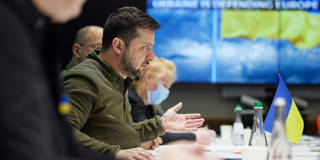The US and NATO have not spoken publicly about a final diplomatic settlement in Ukraine, and Ukrainian President Volodymyr Zelensky’s government, understandably focused on maintaining national unity, has publicly stated its positions only in somewhat contradictory bits and pieces. But it is time to outline what peace would look like.
NEW YORK – On March 7, Russia stated three aims for its invasion of Ukraine: official Ukrainian neutrality, recognition of Russian sovereignty over Crimea, and recognition of the independence of pro-Russian separatist regions in Luhansk and Donetsk. The United States and NATO have not spoken publicly about a final diplomatic settlement, and, with President Volodymyr Zelensky’s government focused on maintaining national unity and armed resistance to Russia, Ukraine has publicly stated its positions only in somewhat contradictory bits and pieces. But Zelensky, in consultation with the US and Europe, which are backing Ukraine’s war-fighting capacity, should formulate and state what a reasonable peace settlement would look like.

NEW YORK – On March 7, Russia stated three aims for its invasion of Ukraine: official Ukrainian neutrality, recognition of Russian sovereignty over Crimea, and recognition of the independence of pro-Russian separatist regions in Luhansk and Donetsk. The United States and NATO have not spoken publicly about a final diplomatic settlement, and, with President Volodymyr Zelensky’s government focused on maintaining national unity and armed resistance to Russia, Ukraine has publicly stated its positions only in somewhat contradictory bits and pieces. But Zelensky, in consultation with the US and Europe, which are backing Ukraine’s war-fighting capacity, should formulate and state what a reasonable peace settlement would look like.